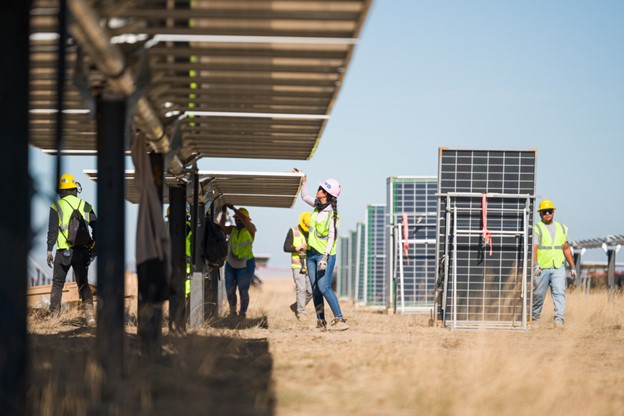In 2023, utility-scale solar installations saw significant global growth, driven by expanding renewable energy adoption and supportive policies. Solar capacity installations reached record levels worldwide, with the U.S. alone adding approximately 33 GW of new solar capacity across multiple sectors, nearly 20 GW of which came from utility-scale projects. While this marks a significant advancement compared to previous years, the industry still faces several challenges not the least of which is a labor shortage.
To better understand the complexities of workforce development in the solar industry, as part of the Solar Jobs Census, IREC conducted a series of interviews and found that companies are seeking workers through partnerships through high schools and vocational schools and they’re using a number of strategies to increase the diversity of the workforce.
The Census found that 29% of employers across the solar industry reported it was “very difficult” to hire qualified workers. While still high, it is down from 44% in 2022. Another 57% said it was somewhat difficult and only 15% found hiring to be not at all difficult.
What it takes to work in solar
The Solar and energy storage industry have a range of jobs for candidates from a spectrum of educational backgrounds and experience. According to IREC, just under half (43%) of new positions in 2023 required a bachelor’s degree, while other positions required an associate’s degree, certificate, or credential. Most positions (75%), require previous experience, including 63% of roles in the manufacturing sector. Educational requirements are highest for wholesale trade and distribution, with 93% requiring a bachelor’s degree.
Challenges
In the solar industry, the sector with the highest reported rate of difficulty hiring is the installation and project development sector. In this sector, the percentage of firms saying it was very difficult to find qualified workers fell from 52% to 33%.
Several challenges in hiring solar installers were mentioned by respondents, emphasizing the need for more active recruitment techniques. Job seekers also have a choice of solar installers to work for. Partnering with local high schools and vocational/community colleges helps to build a pipeline of workers, and is a place for recruitment; however, the Census notes that this takes time and investment.
Pay is another way of attracting workers, with respondents expressing the need for the industry to have livable wages to attract candidates. However, solar workers are paid the same as what they’d make in other industries. According to the U.S. Bureau of Labor Statistics, the median hourly wage for solar installers in 2023 was $23.46, a 7.9% increase from 2022. This is compared to $21.78 for construction laborers and $24.05 for roofers in 2023. The median hourly wage for all U.S. occupations was $23.11.
Wages vary widely depending on the position, experience and educational requirements, and location, according to IREC. The Solar Career Map includes descriptions and sample wage ranges for 44 job roles in the solar industry.
Manufacturing was the only sector that saw an increase in hiring difficulty in 2023. In this sector, 33% of employers found it very difficult to find qualified workers, a 13 percentage point increase since 2022. This may be a reflection of the rapid increase in solar manufacturing in the U.S., which is bringing more jobs that need to be filled.
The most difficult roles to fill were management positions, at 30%, followed by engineers and scientists at 24% and installation workers at 20%.
Union representation
Union representation in the solar workforce is nearly double that of the private sector workforce in the U.S. and also higher than the overall U.S. workforce. The new prevailing wage and apprenticeship requirements for utility-scale solar projects are now in effect, and they encourage union representation.
This content is protected by copyright and may not be reused. If you want to cooperate with us and would like to reuse some of our content, please contact: editors@pv-magazine.com.









By submitting this form you agree to pv magazine using your data for the purposes of publishing your comment.
Your personal data will only be disclosed or otherwise transmitted to third parties for the purposes of spam filtering or if this is necessary for technical maintenance of the website. Any other transfer to third parties will not take place unless this is justified on the basis of applicable data protection regulations or if pv magazine is legally obliged to do so.
You may revoke this consent at any time with effect for the future, in which case your personal data will be deleted immediately. Otherwise, your data will be deleted if pv magazine has processed your request or the purpose of data storage is fulfilled.
Further information on data privacy can be found in our Data Protection Policy.